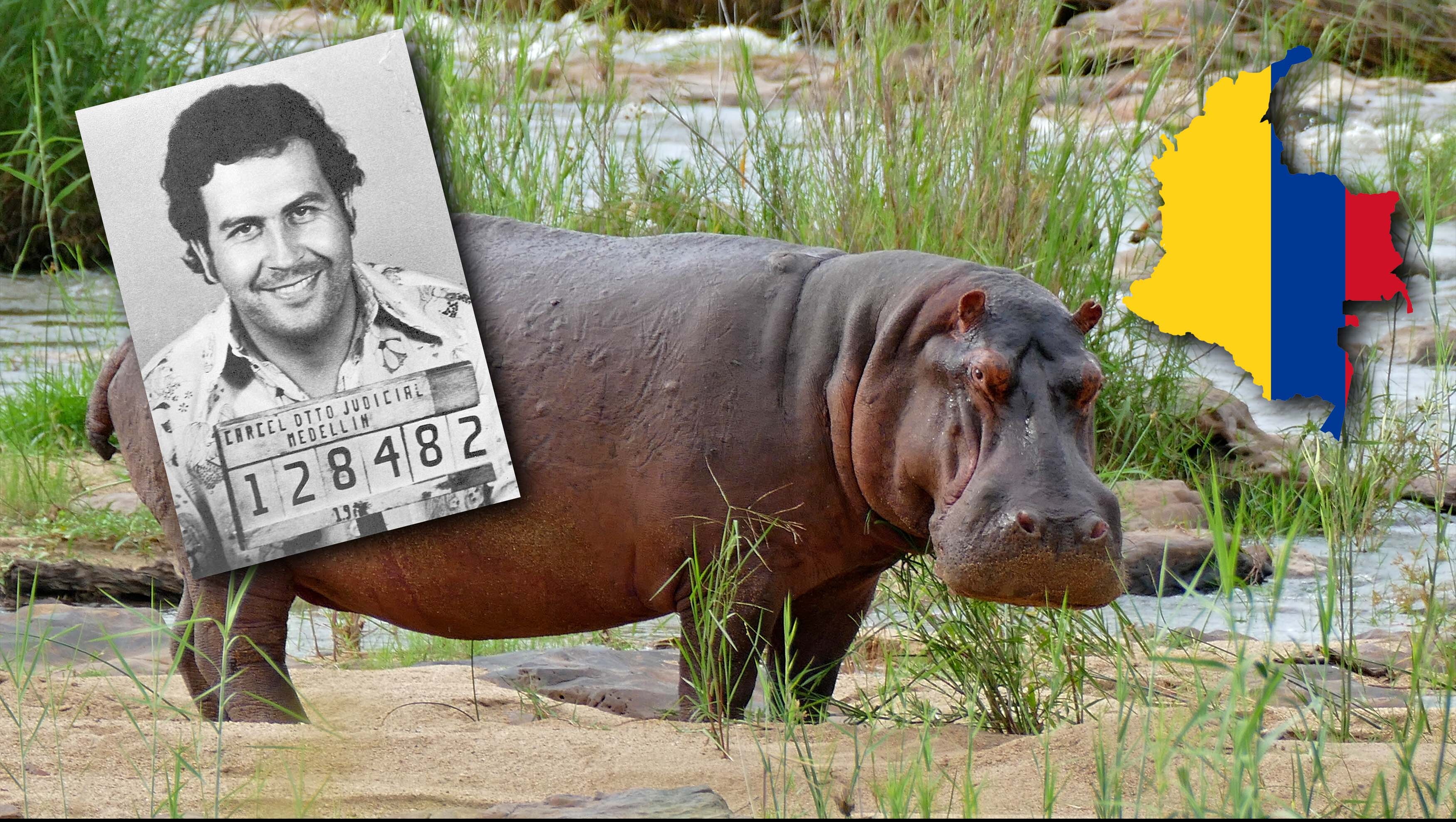Pablo Escobar’s Cocaine Hippos
Colombia’s Cocaine Kingpin smuggled 4 hippos onto his estate in the late 70s and now, almost 30 years after his death, they’ve multiplied into a bloat of more than 100 animals, roaming the Magdalena River Valley and terrorizing citizens and their crops. In this episode, we talk about Colombia’s “Cocaine Hippos,” then chat with Comedian and Political Commentator John Fugelsang, and we argue as to whether or not hippos can swim.

There’s a spot about 3 hours’ drive from the city of Medellin known as Hacienda Nápoles. These days, there’s a small water park and zoo, but if you look around, you’ll see the foundations of demolished buildings. Those buildings in the small town of Puerto Triunfo, demolished almost 30 years ago, used to be the grand palace of famed Colombian Cocaine Kingpin, Pablo Escobar.
At the height of his operation, Pablo Escobar had everything. His net worth was $30 billion dollars – equivalent to around twice that in today’s money. He was the world’s richest man in 1989 and his cocaine cartel was earning him $420 million a week at its peak. He owned 141 houses, 142 airplanes, 20 helicopters, 32 yachts and to this day, he’s sort of seen as both a villain and a hero.
The reason that he leaves a complicated legacy is that, to many people, he ran a drug cartel that devastated several nations in their effort to combat drug crime and the crimes associated with it. He supplied 85% of the cocaine that the world was consuming. His reign killed over 4,000 civilians, 1,000 police officers, 200 judges and included unspeakable violence, including the purposeful bombing of Avianca Flight 203, which killed over 100 people. I want to make sure I’m not making light of the horrible effects of Escobar and Medellin Drug Cartel. The reason that he’s seen as a hero in Colombia – specifically with poorer members of society – is that when you’re that powerful in an impoverished area, you’re the one supplying money, houses and jobs to the community. For people who were in Medellin in the 80s and 90s, they remember a Pablo Escobar that provided the community with thousands of houses, a city sanitation system, parks and soccer fields, schools and cars and buses. Due to the fact that he had so much money, his riches truly did trickle down to the economy of Medellin.
That’s why, in addition to a water park and zoo, the tourist attraction at Hacienda Nápoles includes a Pablo Escobar museum that showcases some of the vehicles, cars, airplanes that he owned as well as some of the burned ruins of his house. People revere him and wonder at the memory of his legacy, even though Escobar was a man that caused severe pain and anguish throughout Colombia, Mexico and The United States.
A man like Escobar could have whatever he wanted. And at one point in the late 1970s, what he wanted were 4 hippos. Let’s talk about hippos for a minute.
There’s only one part of the world where the Hippopotamus lives in its natural habitat – Sub-Saharan Africa. It’s up there with the Elephant and Rhinoceros as one of the top three largest land animals – weighing in at over 3,000 lbs fully grown. Despite their giant size, they can run up to 30 miles an hour and are one of the deadliest land animals. Back in their home region of Africa, hippos kill 500 people a year. They don’t have too many predators in the animal kingdom and they’re constantly facing threats from humans, including poachers and the effects of the war in the Congo. This has given the African Hippopotamus a vulnerable status from the International Union for Conservation of Nature. And because they are so freaking rare, you can’t just buy hippos because you want to see them roaming around your house. That is, unless your name is Pablo Escobar and you’re the richest drug trafficker in history.
It started with just 4 hippos. He had a dream of having the biggest private zoo in the world, so he illegally smuggled 3 females and one male Hippopotamus from Africa to his ranch at Hacienda Nápoles. This initial bloat of hippos was allowed to graze on his Puerto Triunfo property. He showed them off to friends and was proud of the hippos.
I mentioned a little bit earlier about how influential and powerful Pablo Escobar was. It was because of his influence and political connections that when he was arrested for a 5 year prison term in 1991, he was allowed to build his own self-built prison – La Catedral – which was basically just another home. Even then – he couldn’t stand to be imprisoned and escaped from the home. Two years later, Pablo Escobar was found and killed in a shootout with the National Police of Colombia. At this point, the government of Colombia seized and/or destroyed a lot of Escobar’s property. The planes, the cars, the houses – but when it came to the hippos, they simply didn’t have any way of handling them. The hippos roamed free and couldn’t be rounded up. They were left on his Hacienda Nápoles estate.
These days if you visit Hacienda Nápoles, you’ll drive through a big white gate with an airplane on top of it. It’s a replica of the airplane Escobar used to smuggle his first shipments of cocaine. There are water park slides, a small zoo, and a couple small museums and attractions. Gone are the private airport, the mansion, the many buildings, the race track, the brothel, the tennis courts but not the spirit of Pablo Escobar. Like the giant Dinosaur sculptures he had constructed for his son. His burned out car collection is still there for all to see. And while most of his zoo animals were sent to other zoos in and out of Colombia, the hippos still roam free. One of them, named Vanessa, even answers to her name.
By 2007, the 4 original hippos had grown to a pod of 16. By 2014, locals were counting as many as 40. Now, it’s suspected that the Magdalena River basin is home to more than 100 hippos, all roaming free in a land where they have no predators, and where the climate and food sources are perfect for them to thrive. The Magdalena River is slow-moving, which is ideal for them, and the region never experiences droughts, which is one of the factors that curb hippo populations in Africa. They seem to have evolved to mostly be more tame than their African counterparts, though there have been a few dangerous encounters. These hippos are also reaching sexual maturity at an earlier age than in their natural African habitat. A normal hippo starts giving birth around 9 to 11 years old, but the offspring of Escobar’s hippos are active as young as three.
It’s not all sunshine and rainbows though. These are still incredibly dangerous animals. And they’re spreading further and further away from the Hacienda Nápoles estate. Some have been found 155 miles from Puerto Triunfo. Fishermen in the Magdalena River are justifiably terrified of them. Ranchers and farmers have had run-ins with them as they eat valuable crops and have even trampled cows. In 2020, one hippo ran down and injured a farmer, but to this day, they have not killed any people.
The question of what to do with Colombia’s hippos is a constant source of debate within the country. When authorities killed one of the hippos in 2009, the public became upset. Some see the small population of thriving hippos as a sort of conservation of a species that is vulnerable in Africa. Others see it as an extension of Escobar’s legacy. But Colombian authorities are concerned with the population, which they say could pose a threat to the region’s natural biodiversity. Their hope is to castrate the male hippos of the bloat. They argue that the giant animals could possibly carry disease and are seen as an invasive species. If unchecked, the hippo population in Colombia will grow to 400 in the next eight years. By 2035, that number will be 1,500. 1,500 hippos in Colombia. It will be at that point, experts say – that tragic interactions between Colombian citizens and Hippos will be unavoidable. In 2021, an American court determined that Colombian hippos could be given legal status as “people.” But this obviously has zero bearing on what happens in Colombia.
As of right now, no definite plan has been agreed upon and no one is quite sure what to do with Colombia’s Cocaine hippos. So they remain – wandering the Magdalena River Basin and reminding everyone of the infamous drug kingpin who introduced them.

Review this podcast at https://podcasts.apple.com/us/podcast/the-internet-says-it-s-true/id1530853589
Bonus episodes and content available at http://Patreon.com/MichaelKent
For special discounts and links to our sponsors, visit http://theinternetsaysitstrue.com/deals

